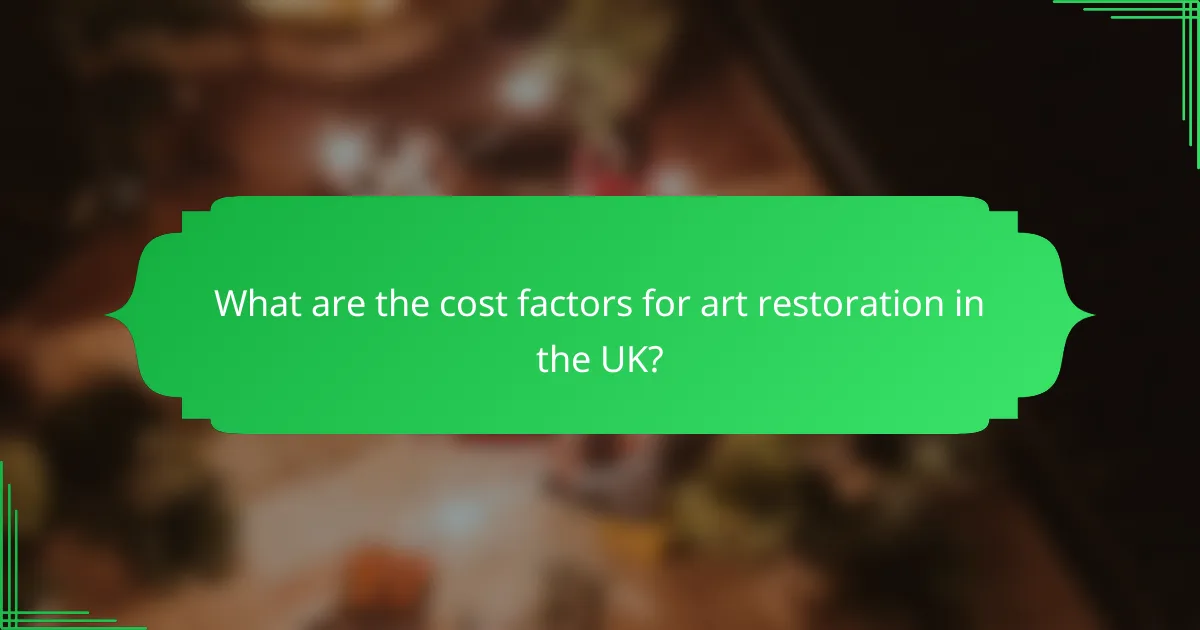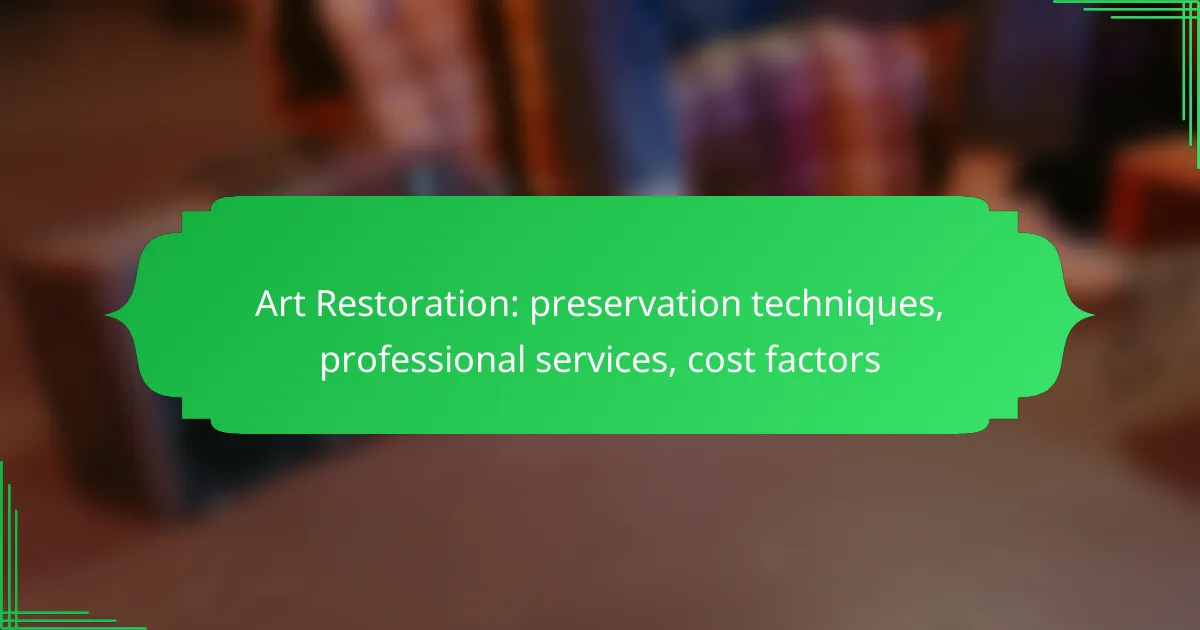Art restoration is a vital process that aims to preserve the integrity and aesthetics of artworks while enhancing their longevity. In the UK, various techniques such as cleaning, consolidation, and structural repairs are employed by professional services to meet the specific needs of each piece. When selecting a restoration service, it’s essential to consider their expertise and track record, as costs can vary significantly based on several factors.

What are the best art restoration techniques in the UK?
The best art restoration techniques in the UK focus on preserving the integrity and aesthetics of artworks while ensuring their longevity. These methods include cleaning, consolidation, repainting, varnishing, and structural repairs, each tailored to the specific needs of the artwork.
Cleaning and surface restoration
Cleaning and surface restoration involve removing dirt, grime, and previous restoration materials without damaging the original artwork. Techniques can range from dry cleaning with soft brushes to using solvents for more stubborn residues. It’s essential to assess the artwork’s condition before selecting a cleaning method to avoid unintentional harm.
Restorers often conduct tests on small, inconspicuous areas to determine the safest cleaning approach. Regular maintenance can help prevent the buildup of contaminants, prolonging the artwork’s life.
Consolidation and stabilization
Consolidation and stabilization techniques are used to strengthen fragile or deteriorating materials, such as canvas or wood. This process may involve applying adhesives or consolidants that penetrate the material to provide support without altering its appearance. Restorers must choose materials compatible with the original artwork to maintain its authenticity.
It’s crucial to monitor the artwork’s environment, as fluctuations in temperature and humidity can exacerbate deterioration. Proper framing and display can also contribute to stabilization.
Repainting and inpainting
Repainting and inpainting are techniques used to restore lost or damaged areas of an artwork. Inpainting involves carefully filling in missing sections with paint that matches the original, while repainting may be necessary for larger areas. Skilled restorers use reversible materials to ensure that future restorations can be made without damaging the original work.
Choosing the right pigments and methods is vital to achieving a seamless blend with the original artwork. Documentation of the restoration process is essential for future reference.
Varnishing and protective coatings
Varnishing and protective coatings serve to enhance the appearance of artworks while providing a barrier against environmental damage. Varnishes can protect against dust, UV light, and moisture, but they must be applied carefully to avoid altering the artwork’s colors or textures. Restorers often recommend using removable varnishes to allow for future cleaning and restoration.
Regular inspections are important to determine when a new layer of varnish may be needed, as older varnishes can yellow or become cloudy over time.
Structural repairs
Structural repairs address physical damage to the artwork, such as tears, cracks, or warping. Techniques may include patching tears with compatible materials, reinforcing weak areas, or re-stretching canvases. Each repair should be executed with care to maintain the artwork’s original structure and appearance.
Restorers must evaluate the extent of damage and choose appropriate materials that align with conservation standards. Proper handling and storage of artworks can help prevent structural issues from arising in the first place.

How to choose a professional art restoration service in the UK?
Selecting a professional art restoration service in the UK involves evaluating their expertise, past performance, and communication style. Prioritize services that demonstrate a strong track record in preserving artworks similar to yours and ensure they maintain industry standards.
Check qualifications and certifications
Additionally, inquire about their educational background and any specialized training in art restoration techniques. This can provide insight into their skill level and the methods they employ.
Review past work and case studies
Examine the portfolio of the restoration service to assess their previous projects. Look for case studies that showcase their ability to handle artworks similar to yours, including the types of materials and techniques used. This can help you gauge their experience and expertise.
Request references or testimonials from past clients to understand their satisfaction with the service. Positive feedback can indicate reliability and quality of work.
Assess communication and consultation
Effective communication is crucial when working with an art restoration service. During initial consultations, evaluate how well they listen to your concerns and explain their processes. A good restorer should be able to articulate their methods and the rationale behind their recommendations.
Ensure that they provide clear timelines and cost estimates. Transparency in pricing and project duration can prevent misunderstandings and help you make informed decisions about your restoration needs.

What are the cost factors for art restoration in the UK?
The cost of art restoration in the UK can vary significantly based on several key factors. Understanding these factors helps in budgeting for restoration projects and selecting appropriate services.
Type of restoration required
The type of restoration needed plays a crucial role in determining costs. For instance, simple cleaning may be less expensive than extensive repairs or conservation of damaged pieces. Specific techniques, such as retouching or varnishing, can also influence the overall price.
Additionally, the medium of the artwork affects the restoration type. Oil paintings, watercolors, and sculptures each require different approaches, which can lead to varying costs.
Size and complexity of the artwork
The size and complexity of the artwork significantly impact restoration expenses. Larger pieces often require more time and materials, leading to higher costs. Complex artworks with intricate details may also necessitate specialized skills, further increasing the price.
For example, a small canvas might cost a few hundred pounds to restore, while a large mural could run into the thousands, depending on the work involved.
Materials and techniques used
The materials and techniques employed during restoration can greatly affect the overall cost. High-quality, conservation-grade materials tend to be more expensive but are essential for preserving the integrity of the artwork.
Techniques such as inpainting or using specific adhesives may require specialized training and tools, which can add to the expense. It’s important to discuss these options with the restorer to understand their implications on the budget.
Location and service provider reputation
The location of the restoration service and the reputation of the provider can also influence costs. Established conservators in major cities like London may charge premium rates compared to those in smaller towns.
Choosing a highly regarded service provider often ensures better quality work, but it may come at a higher price. It’s advisable to compare multiple quotes and check reviews to find a balance between cost and quality.

What are the benefits of professional art restoration?
Professional art restoration offers significant advantages, including the preservation of valuable cultural artifacts, enhancement of artwork value, and improvement of visual appeal. Engaging experts ensures that techniques used are appropriate and effective, safeguarding the integrity of the piece.
Preservation of cultural heritage
Professional art restoration plays a crucial role in preserving cultural heritage by maintaining the historical significance of artworks. Experts utilize specialized techniques to repair damage while respecting the original materials and methods used in the creation of the piece.
Restoring artworks can involve cleaning, repairing tears, and stabilizing fragile elements, which helps to ensure that future generations can appreciate these cultural treasures. This preservation is vital for museums, galleries, and private collectors alike, as it contributes to the broader understanding of art history.
Increased artwork value
Restored artworks often see an increase in market value, making professional restoration a worthwhile investment. A well-executed restoration can enhance the piece’s appeal to collectors and investors, leading to higher sale prices.
Factors influencing value include the quality of the restoration, the artist’s reputation, and the artwork’s historical context. It is essential to document the restoration process thoroughly, as this transparency can further boost the artwork’s value in the eyes of potential buyers.
Enhanced aesthetic appeal
One of the most immediate benefits of professional art restoration is the enhanced aesthetic appeal of the artwork. Restoration can revitalize colors, remove unsightly stains, and repair physical damage, allowing the piece to be appreciated as intended by the artist.
Artworks that are well-restored can captivate audiences and create a more engaging experience in galleries or private collections. However, it is crucial to ensure that restoration techniques do not compromise the original integrity of the piece, as this can detract from its overall value and significance.

What are common challenges in art restoration?
Art restoration faces several challenges, including material degradation and ethical considerations. These factors can significantly impact the approach and techniques used in preserving artworks.
Material degradation
Material degradation occurs when the physical and chemical properties of art materials deteriorate over time. Common causes include environmental factors like humidity, temperature fluctuations, and exposure to light, which can lead to fading, cracking, or mold growth.
Restorers must assess the extent of degradation and choose appropriate methods for stabilization. Techniques may include cleaning, repairing, or replacing damaged components, always aiming to retain the original integrity of the artwork.
Ethical considerations
Ethical considerations in art restoration revolve around the balance between preserving an artwork’s original state and enhancing its appearance. Restorers must make decisions that respect the artist’s intent while ensuring the piece’s longevity.
Common ethical dilemmas include the use of invasive techniques or materials that could alter the artwork’s authenticity. Professionals often adhere to guidelines from organizations like the American Institute for Conservation, which emphasize minimal intervention and transparency in restoration practices.
